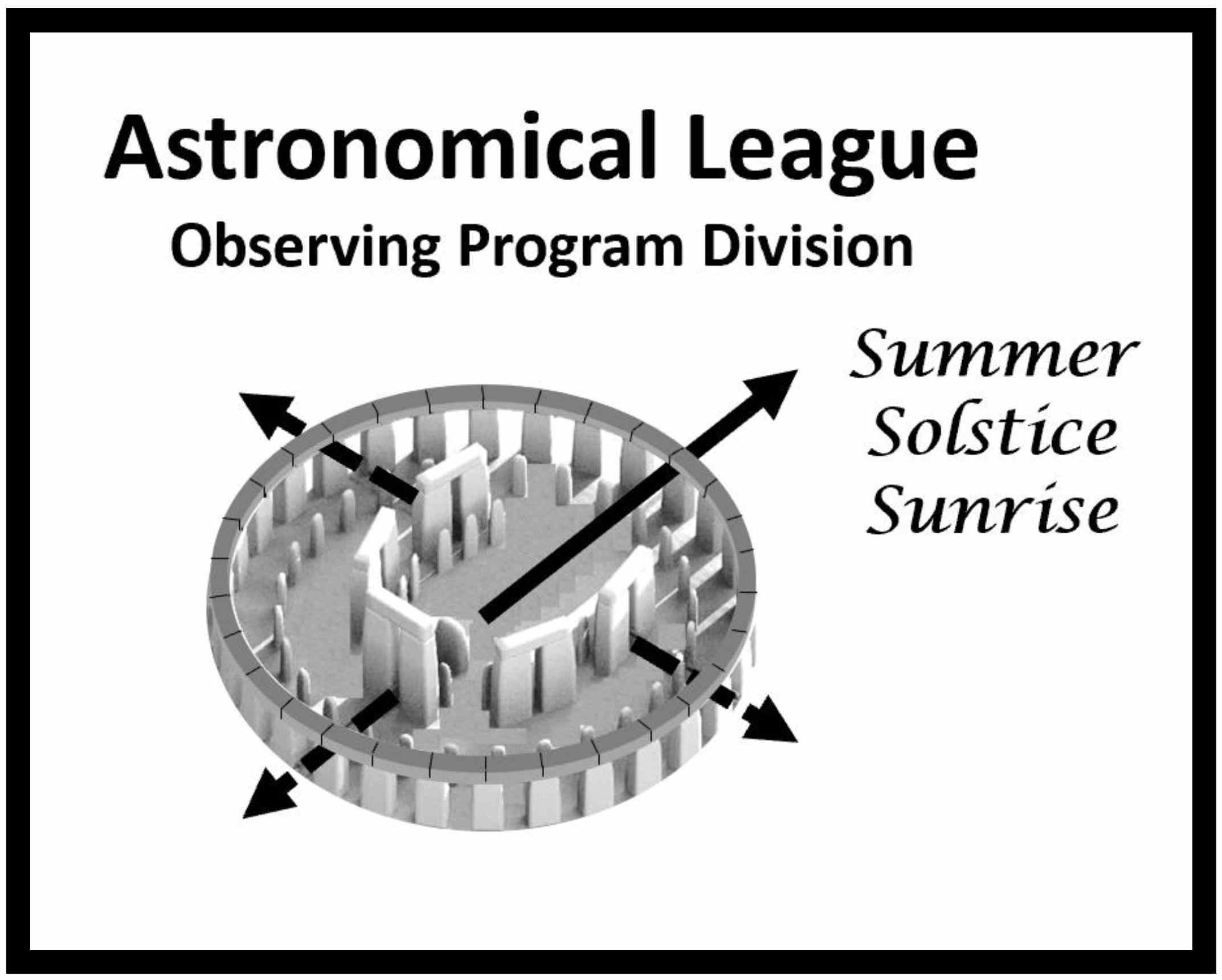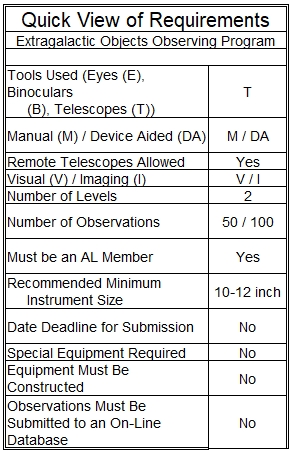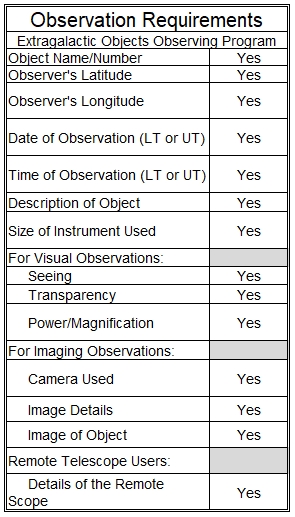Extragalactic Object Observing Program Coordinator:Al Lamperti |
 |
Introduction
|
 |
Background
Perhaps not surprisingly, many extragalactic objects have NGC or IC designations, especially those found within our close galactic neighbors: M 31, M 33, the Large & Small Magellanic Clouds. With the advent of larger ground-based telescopes and space-based telescopes, more and more of these extragalactic objects are being discovered and studied and compared to similar ones in our own galaxy. For example, the massive globular clusters omega Centauri and M 54 are thought to have been the remnants of cannibalized dwarf galaxies. Rejkuba et al (2007) studied bright globular clusters in NGC 5128 and provided evidence for a link between old globular clusters, young massive clusters and evolved objects like ultra compact dwarf galaxies. Understanding the dynamics of these XGOs in host galaxies furthers our general understanding of galactic evolution.
Types of Extragalactic Objects
- H II regions/Emission nebulae – large areas of ionized hydrogen indicative of star formation.
- Dark nebulae – large areas of dust and gas so dense that light does not penetrate them.
- Open clusters – a localized collection “young” bright stars, tens to hundreds of millions of years old.
- Globular clusters – a compact collection of “older” stars, ~12+ billion years old.
- Star associations – a very large, dispersed group of stars: high solar masses: O = 15-90 M☉, B = 2-15 M☉; medium solar masses: R = 3-10 M☉; low solar mass: T = similar to our Sun.
- Planetary nebulae – remnants of a dying star.
- Supernova remnants – remnants of a dying star.
- Supergiant stars – most massive and most luminous stars.
- Wolf-Rayet stars – hot, massive stars losing mass at a very high rate.
- Jets – a stream of particles and plasma from an interaction between a black hole and its accretion disk.
There are two additional types of objects that may be included. They are not on the lists of objects because they cannot be predicted
- Novae – a white dwarf in a binary pair where material from the other star accretes on the surface of the white dwarf. When enough material accumulates, nuclear fusion initiates and the star becomes many times brighter than normal.
- Supernovae – either a large star reaches the end of its life, or a white dwarf (as mentioned above) exceeds 1.4 solar masses. At that point there is a massive explosion and it becomes extremely bright; often brighter than its host galaxy.
Requirements and Rules
This certification is available to members of the Astronomical League, either through their local astronomical society or as members at large. If you are not a member and would like to become one, check with your local astronomical society, search for a local society on the Astronomical League Website, or join as a member at large.
|
 |
Submitting for Certification
| The log sheets and electronic files containing digital images (which can be submitted on a CD or through an internet-based delivery system – e.g., website, Drop Box, Google Drive, etc.) can either be sent to the Program Coordinator or to one of your astronomy club officers for verification.
If observations are done 100% manually, the certificate number will have the suffix “-M”. If observations are done 100% through imaging, the certificate numbere will have the suffix “-I”. |
 |
Upon verification of your submission and of your active membership in the Astronomical League, your recognition (certificate, pin, etc.) will be sent to you or to the awards coordinator for your society, as you specified. Your name will also appear in an upcoming issue of the Reflector magazine and in the Astronomical League’s online database. Congratulations. Good luck with your next observing challenge.
Notes:
Acknowledgements:
Numerous publications in amateur astronomy magazines as well as posts on various forums provided the impetus for delving into the host galaxies (see chart references). Thanks to Joe Lamb of the Delaware Valley Amateur Astronomers (DVAA) and John Goss who contributed their suggestions and editorial expertise to the development of this Observing Program. Gary Trapuzzano of the DVAA provided the images used on the certificate. Frank Colosimo of the DVAA kindly gave permission to use his image of M 101 depicted on the pin.
Hints on Observing Extragalactic Objects:
The guide, “Observing Extragalactic Objects within Host Galaxies” by Alvin Huey provides excellent hints as well as finder charts and images. The references listed below also have images and finder charts.
Extragalactic Objjects Observing Program Coordinator:Al Lamperti |
Links:
Appendices:
- Appendix A, list of Extragalactic Objects by Host Galaxy in PDF format.
- Appendix B, list of Extragalactic Objects by Constellation in PDF format.
- Appendix C, list of Extragalactic Objects by Type in PDF format.
- Appendix D, list of Extragalactic Objects by Right Ascension in PDF format.
- Appendix E, list of Extragalactic Objects by Declination in PDF format.
- Appendix F, all of the above lists in an Excel spreadsheet in Excel format.
- Appendix G, sample Log Sheet in MS Word format, in PDF format
References:
Charts
- “Observing Extragalactic Objects within Host Galaxies”, Alvin Huey, 2024, https://faintfuzzies.com/DownloadableObservingGuides2.html
- “A Field Guide to Observing NGC 6946 – The Fireworks Galaxy, Scott Harrington, https://drive.google.com/file/d/1XMCJG1OFlCHX_92tO_-GZ35QN6ylq3wW/view
- “Extragalactic Globular Clusters”, Steve Gottlieb, Sky & Telescope, August 2018 https://skyandtelescope.org/sky-and-telescope-magazine/extragalactic-globular-clusters/“
- “Unraveling NGC 6946” Steve Gottlieb, Sky & Telescope, July 2013, 60-61.
- “The Determined Observer’s Guide to M 101”, Howard Banich, Sjy & Telescope June 2013, 38-41.
- “Digging Deep in Messier 83”, Steve Gottlieb, Sky & Telescope, May 2014, 60-61.
- “Two Cool Galaxies – The Incomparable M 81 and M 82”, Howard Banich, Sky & Telescope May 2016, 18-23.
- “Star-Forming Regions in Faraway Galaxies” Scott Harrington, Sky & Telescope, May 2021, 22-29.
- “Your Complete Field Guide to M 33” Scott Harrington, (the zip file includes: Extragalactic Sights in M33.xlsx; The Brightest Star Clusters of M33.xlsx; The Brightest Star Clusters of M33.pdf; The Brightest Stars of M33.pdf; M33 OBa+ Finder Chart.pdf; M33 Clusters & Stars Finder Chart.pdf) https://drive.google.com/file/d/1jYcDtEl4aekzKgyK-QcAGKhAYuelx03E/view
- “Messier 33 – A Beautiful Spiral Galaxy for Autumnal Skies” Mark Radice, Astronomy Now, October 2024, 28-33.
- “A Field Guide to M 31’s Brightest Observable Globular Clusters & More” Scott Harrington, (the zip file includes: 80+ Extragalactic Objects of M31.xlsx; Main M31 Observing Charts.pdf; Halo Globular Cluster Finder Charts.pdf; Robert Gendler’s [2.2°x1.5°] Mosaic of M31.jpeg; 25 GCs for Telescopes 12-inches & Up.pdf) https://drive.google.com/file/d/1Zbro3JFJVPOEcFh0iwRqpx8Lvxm81_Zd/view
- Large Magellanic Cloud: https://commons.wikimedia.org/wiki/File:Eso1021d.jpg
- Small Magellanic Cloud: https://hubblesite.org/contents/media/images/2020/50/4760-Image?amp;Topic=104-stars-and-nebulas&page=1&keyword=star%20formation
- Small Magellanic Cloud: https://cosmicpursuits.com/wp-content/uploads/2019/03/SMC-Tour.png
Scientific papers
- “Bright Globular Clusters in NGC 5128: the Missing Link Between Young Massive Clusters and Evolved Massive Objects”, M. Rejkuba et al, Astronomy & Astrophysics, 469, 147-162, 2007.
- “The Structure and Environment of Young Stellar Clusters in Spiral Galaxies”, S.S. Larsen, Astronomy & Astrophysics, 416, 537-553, 2004
- “H II Regions as Extragalactic Distance Indicators. IV The Virgo Cluster”, R.C. Kennicutt, The Astrophysical Journal, 247: 9-16, 1981
- “H II Regions in M 81 Group Dwarf Galaxies“, Bruan W. Miller & Paul Hodge, The Astrophysical Journal, 247: 656-675, 1994



